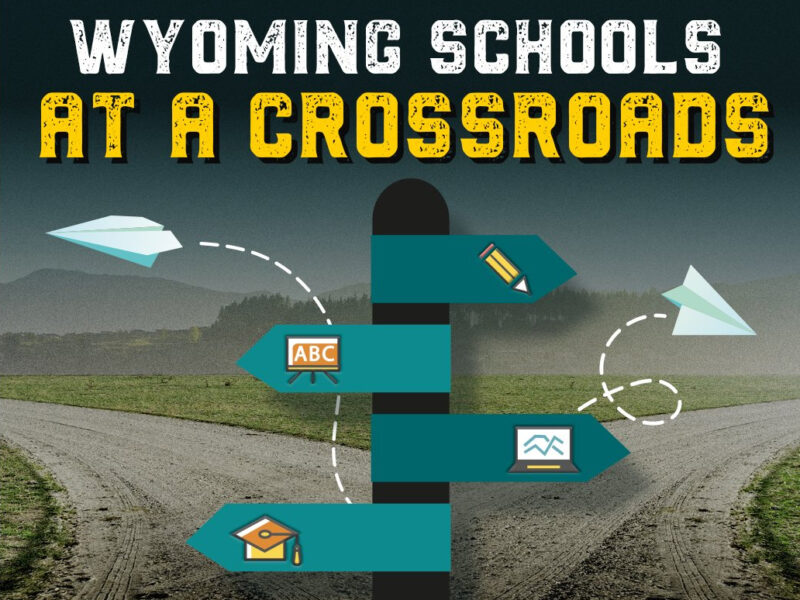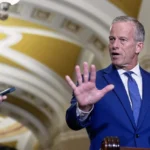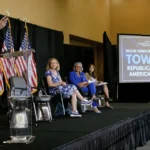WYOMING SCHOOLS AT A CROSSROADS: College Students More Aware of Mental Health Issues After COVID (Part 4)
Laramie, Torrington professors say students face burnout
- Published In: Other News & Features
- Last Updated: Mar 28, 2023

By Elizabeth Sampson
Special to the Wyoming Truth
This is the fourth part of the Wyoming Truth’s Q&A series with educators from across the state about how the COVID-19 pandemic has impacted students of all ages. Check out part one about preschoolers; part two about elementary and middle school students; and part three about high school students.
Today’s college students are likely to have spent part of their high school and college years learning virtually thanks to the COVID-19 pandemic. Two Wyoming college instructors say these students face social struggles and academic as a result.
Ellen Creagar is a professor of political science, history and business law at Eastern Wyoming College in Torrington, where she has taught for 27 years. Amanda Brown has spent nine years at Laramie County Community College in Cheyenne, where she first served as a mental health counselor and now teaches psychology.
Comparing your students pre-COVID to your students today, have you noticed any differences in their behavior?
Creagar: We have way higher evidence of mental health symptoms. Students are far more isolated from each other. You tend to see students alone in the hallway or when eating. I see a lot more high anxiety and a lot more lack of focus. I think all of that is stress from this collective trauma of being isolated.
With the confluence of the masking tension we felt in our communities, families and schools, on top of the 2020 election and how divisive that was, students seem to be way more comfortable challenging faculty. A lot of people have a comfort level in tension, because that’s what they’ve seen the last two years.
Brown: Every cohort has their own identity, so that is just a nuance regardless of COVID or not. But our fourth-semester students, who are graduating this spring, definitely have a preference for virtual learning. They tend to be more independent, looking for their resources online. . . . . This year at LCCC has a completely different feel in regards to student interactions. Our club numbers and engagement [are] up significantly.

What else have you observed?
Creagar: A lot of stress with the student body—some of them come from environments where they had to take jobs during the pandemic to help their families. There’s stress because people lost family members and friends during the pandemic. I have seen a fair bit of super-unfortunate situations, where for about two years these students really lacked in some opportunities they could have taken—like internships that just got canceled.
Brown: I see a lot more high school students coming in with jobs. They’re working part time, if not full time. More students are coming in financially conscientious. They are trying to save their money to go to school. They [don’t want] to take out loans and [try] to be informed in the financial decision they are making.
How is their mental health?
Creagar: My students have said over the last year and a half—and these are 18- and 19-year-old students—“I’m tired, I’m mentally exhausted, I feel burned out, I just don’t think I care anymore.” I feel like there is this epidemic of loneliness and isolation. I think they are having a little bit of trouble getting back into finding meaning in their life.
Brown: Many of them have talked about the need to take a little bit of a break because they feel burned out. I think just the emotional intensity, the heaviness, the stress from life and school has influenced their burnouts. They burn out a lot quicker than maybe previous cohorts….
There is more anxiety, more depression. But I also think it feels like there’s more because students are talking about it more. It’s not uncommon for students to be coming to college already having met with a therapist, knowing what mental health counseling is.
Did you modify your teaching techniques to meet new challenges with your current students?
Creagar: I did not realize how less-prepared academically and socially these folks were going to be. They are way less willing or able to participate in groups and complete work. I have a couple classes where I focus pretty heavily on discussion, and I have to spend quite a bit of time creating the environment that is going to let that happen, because it is hard to get them to talk and share and not just pull back into themselves.
I’ve had to be far more clear about expectations. I am just far more direct about, “This is how you do x or y.” I will sit down and help them write a thank you note for a scholarship. I don’t assume they know how to do any of these things.
Brown: We now offer every 2000 level class for psychology with a synchronous learning option, so students can choose whether they want to come to the class face-to-face or if they want to hop on Microsoft Teams to engage with the course discussion. So every class period, I’m navigating two audiences . . . .
We also have quite a few parents who are trying to navigate caring for their children and going to college or trying to work. Life got busier during COVID and post-COVID. It’s a way of really trying to meet the needs of those individuals that are working and have a lot of tasks on their plates.

Many schools introduced virtual learning during the pandemic. Do your students like this option?
Creagar: The online education has been both positive and negative. A majority of [the students] believe online education degrades the value of their degree, and it’s not a good value—they can cheat easier, they just don’t learn as well. They will tell you this flat out.
What we’ve seen from these young people is we need social interaction, and we need to be able to access each other, ideas, labs and equipment, and all those experiential things. On the flip side, online education for me changed the way I teach. I get deeper, more considered responses in some of the online work I assign. For our second language speakers, the ability to be able to translate the written stuff back and forth has been a benefit.
Brown: We do surveys to ask about their preferences of course style, and the students are saying, “I get more out of learning face-to-face.” For the students coming in, they’re craving face-to-face interaction, face-to-face connection. There’s been a little bit of a shift. That previous cohort, I have more students engaging synchronously, attending virtually. That was more the norm for them coming out of high school. They were the students that didn’t get to experience graduation.
[But students] also appreciate virtual learning options, such as the flexibility to engage in virtual learning if life presents a circumstance where they can’t be face-to-face. I have students who attend classes sick virtually. They would have missed out on those opportunities before.
What strengths have you noticed in students who navigated a global pandemic as part of their life story?
Creagar: They are more flexible. If I were to say to them, “I can’t be here tomorrow. I’m going to Zoom record my lecture. Log on and do it,” they would just do [it]. That would have just freaked everybody out if you tried that before.
Brown: I have students coming in who have been researching on their own for years the topics they are interested in . . . . They know their resources, and they know how to find information. They are really skilled at deciphering through what is credible and what isn’t. The pandemic forced people, especially those younger individuals, to know their sources of information. They really had to develop information literacy skills in order to develop an opinion.
What do you hope people will understand about today’s college students?
Creagar: This whole generation just makes me happy. My hope is resting on these 18 to 25-year-olds. They are the voice of America, and they are an incredibly interesting, diverse, thoughtful group of people.
Brown: They are passionate about creating a world that feels safe and welcoming for everyone. They have an open mind to making sure people feel respected, they feel heard, they feel valued and validated. They are going to be the ones who repair the hurt that has happened in the last few years.













